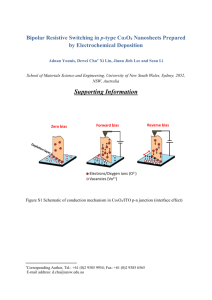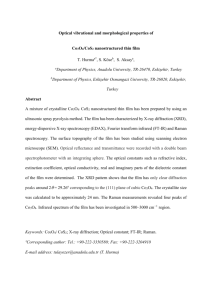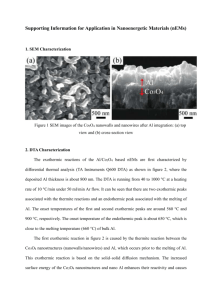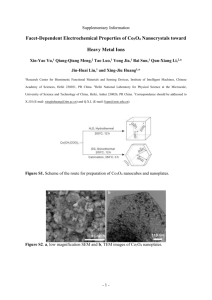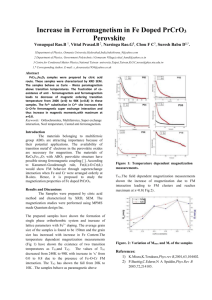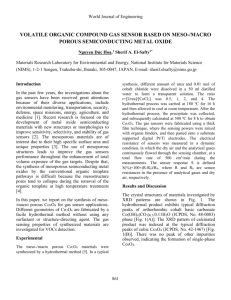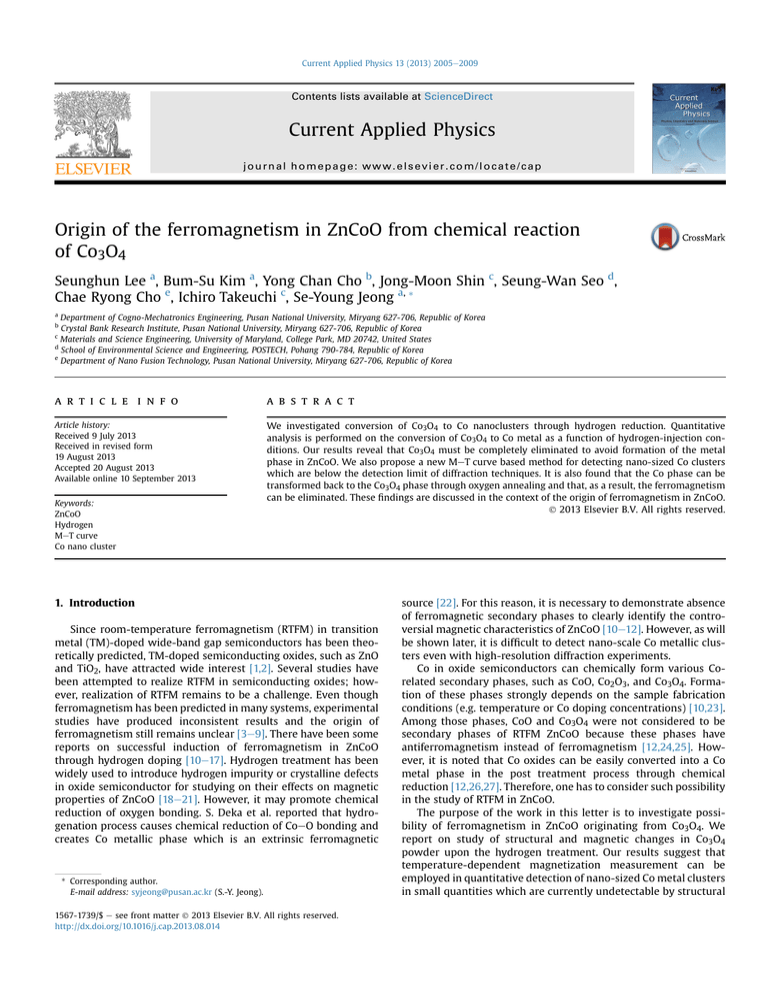
Current Applied Physics 13 (2013) 2005e2009
Contents lists available at ScienceDirect
Current Applied Physics
journal homepage: www.elsevier.com/locate/cap
Origin of the ferromagnetism in ZnCoO from chemical reaction
of Co3O4
Seunghun Lee a, Bum-Su Kim a, Yong Chan Cho b, Jong-Moon Shin c, Seung-Wan Seo d,
Chae Ryong Cho e, Ichiro Takeuchi c, Se-Young Jeong a, *
a
Department of Cogno-Mechatronics Engineering, Pusan National University, Miryang 627-706, Republic of Korea
Crystal Bank Research Institute, Pusan National University, Miryang 627-706, Republic of Korea
Materials and Science Engineering, University of Maryland, College Park, MD 20742, United States
d
School of Environmental Science and Engineering, POSTECH, Pohang 790-784, Republic of Korea
e
Department of Nano Fusion Technology, Pusan National University, Miryang 627-706, Republic of Korea
b
c
a r t i c l e i n f o
a b s t r a c t
Article history:
Received 9 July 2013
Received in revised form
19 August 2013
Accepted 20 August 2013
Available online 10 September 2013
We investigated conversion of Co3O4 to Co nanoclusters through hydrogen reduction. Quantitative
analysis is performed on the conversion of Co3O4 to Co metal as a function of hydrogen-injection conditions. Our results reveal that Co3O4 must be completely eliminated to avoid formation of the metal
phase in ZnCoO. We also propose a new MeT curve based method for detecting nano-sized Co clusters
which are below the detection limit of diffraction techniques. It is also found that the Co phase can be
transformed back to the Co3O4 phase through oxygen annealing and that, as a result, the ferromagnetism
can be eliminated. These findings are discussed in the context of the origin of ferromagnetism in ZnCoO.
Ó 2013 Elsevier B.V. All rights reserved.
Keywords:
ZnCoO
Hydrogen
MeT curve
Co nano cluster
1. Introduction
Since room-temperature ferromagnetism (RTFM) in transition
metal (TM)-doped wide-band gap semiconductors has been theoretically predicted, TM-doped semiconducting oxides, such as ZnO
and TiO2, have attracted wide interest [1,2]. Several studies have
been attempted to realize RTFM in semiconducting oxides; however, realization of RTFM remains to be a challenge. Even though
ferromagnetism has been predicted in many systems, experimental
studies have produced inconsistent results and the origin of
ferromagnetism still remains unclear [3e9]. There have been some
reports on successful induction of ferromagnetism in ZnCoO
through hydrogen doping [10e17]. Hydrogen treatment has been
widely used to introduce hydrogen impurity or crystalline defects
in oxide semiconductor for studying on their effects on magnetic
properties of ZnCoO [18e21]. However, it may promote chemical
reduction of oxygen bonding. S. Deka et al. reported that hydrogenation process causes chemical reduction of CoeO bonding and
creates Co metallic phase which is an extrinsic ferromagnetic
* Corresponding author.
E-mail address: syjeong@pusan.ac.kr (S.-Y. Jeong).
1567-1739/$ e see front matter Ó 2013 Elsevier B.V. All rights reserved.
http://dx.doi.org/10.1016/j.cap.2013.08.014
source [22]. For this reason, it is necessary to demonstrate absence
of ferromagnetic secondary phases to clearly identify the controversial magnetic characteristics of ZnCoO [10e12]. However, as will
be shown later, it is difficult to detect nano-scale Co metallic clusters even with high-resolution diffraction experiments.
Co in oxide semiconductors can chemically form various Corelated secondary phases, such as CoO, Co2O3, and Co3O4. Formation of these phases strongly depends on the sample fabrication
conditions (e.g. temperature or Co doping concentrations) [10,23].
Among those phases, CoO and Co3O4 were not considered to be
secondary phases of RTFM ZnCoO because these phases have
antiferromagnetism instead of ferromagnetism [12,24,25]. However, it is noted that Co oxides can be easily converted into a Co
metal phase in the post treatment process through chemical
reduction [12,26,27]. Therefore, one has to consider such possibility
in the study of RTFM in ZnCoO.
The purpose of the work in this letter is to investigate possibility of ferromagnetism in ZnCoO originating from Co3O4. We
report on study of structural and magnetic changes in Co3O4
powder upon the hydrogen treatment. Our results suggest that
temperature-dependent magnetization measurement can be
employed in quantitative detection of nano-sized Co metal clusters
in small quantities which are currently undetectable by structural
2006
S. Lee et al. / Current Applied Physics 13 (2013) 2005e2009
diffraction measurements. Given these findings, we assert that
Co3O4 phase should be carefully examined and removed prior to
the post treatments to prevent ferromagnetic contribution from Co
metal cluster in ZnCoO.
2. Experimental details
Co3O4 powder was fabricated by the solegel method, which is
conventionally used for fabricating ZnCoO, as described in our
previous reports [10e13]. Radio frequency (rf) plasma treatment
was used for the hydrogen injection process. Co3O4 powders were
exposed for 10 min per treatment to hydrogen plasma with varying
rf-power (20 w 80 W), using Ar:H2 (9:1 vol%) mixed gas. X-ray
diffraction (XRD) was performed to examine change in crystallinity
as well as formation of secondary phases. Magnetization characteristic was determined as a function of the applied magnetic field
(MeH) and temperature (MeT), using a vibrating sample magnetometer installed in the physical-property measurement system
(VSM: model 6000, Quantum Design, Inc.).
3. Result and discussion
Fig. 1 shows the MeH and MeT curves of Co3O4 powder samples, heat-treated at two different temperatures (300 C and
500 C). The XRD patterns of both Co3O4 samples correspond to
that of pure Co3O4 phase; no other Co-related secondary phases
were observed within the detection limit of the measurement,
irrespective of the heat-treatment temperature (not shown here).
The peak widths of both Co3O4 powder samples were almost the
same, which indicates similar particle sizes in the samples. MeH
curves of the Co3O4 sample heat-treated at 300 C show a ferromagnetic hysteresis loop both at 300 K and 10 K (Fig. 1(a)). Its MeT
curve (Fig. 1(b)) shows a weak sign of an inflection temperature.
The temperature is close to the Neel temperature of Co3O4
(TN ¼ 40 K [24]), but the magnetic transition was not clear. It was
assumed to be related to coexistence of some ferromagnetic phases
and antiferromagnetic Co3O4. However, MeH curves of Co3O4 heattreated at 500 C exhibits a linear behavior both at 300 K and 10 K
(Fig. 1(c)). Besides, its MeT curve clearly shows a Neel temperature
at 40 K (Fig. 1(d)), which is the intrinsic behavior of Co3O4 [24]. The
magnetization of the sample heat-treated at 500 C decreases to
about one sixth of that of the sample treated at 300 C. Note that all
XRD patterns of samples treated at 300 C correspond to singlephase Co3O4; thus, it may be concluded that the ferromagnetism
is caused by Co organic compounds, nano size effect [28,29] or
ferromagnetic precipitates beyond the XRD detection limit which
can be eliminated by high temperature heat treatment.
We examined changes in structural and magnetic properties of
Co3O4 as a function of hydrogen injection with various degrees of rf
power and number of sample exposure to the plasma. Co3O4
powder fabricated at 500 C was used for this study, which exhibits
the typical characteristics of Co3O4 with a Neel temperature. Fig. 2
shows XRD patterns from Co3O4 powders for various hydrogentreatment conditions. The numbers on the left and right sides of
the hyphen (-) in each label denote the rf-power and number of
hydrogen plasma exposure, respectively (e.g. H20-4 means Co3O4
powder treated at 20 W for 4 times.). The sample H40-1 showed
only the Co3O4 single phase within the XRD detection limit. The
samples hydrogenated at <40 W are not presented here because
they show results very similar to that of single phase Co3O4.
However, additional peaks comparable to the background noise
level arise in the XRD pattern for H60-1. These correspond to CoO
and hexagonal Co metal phases (marked by the green asterisks in
the diffraction patterns for each sample), and are attributed to the
reduction of Co3O4 by hydrogen treatment [12]. Additional
diffraction patterns are more clear with the rf-power is increased as
shown in XRD pattern for H80-1. However, even in the logarithm
scale plot of the intensity for clear observation of the background
level, it is not easy to clearly identify them. It reflects the difficulty
in the detection of secondary phases in oxide semiconductors due
to the fact that their quantity and size are smaller than the detection limit of diffraction techniques.
We instead try to see the changes in magnetic properties as a
function of hydrogen injection. To do it, the MeH and MeT curves
were obtained for various hydrogen plasma conditions as shown in
Fig. 3. Fig. 3(a) shows MeH curves for H20-1 and H20-4 samples.
Fig. 1. (a) Magnetizationeapplied magnetic field (MeH) characteristics and (b) magnetizationetemperature (MeT) characteristics of Co3O4 after thermal treatment at 300 C. (c)
MeH and (d) MeT characteristics of Co3O4 powder after thermal treatment at 500 C.
S. Lee et al. / Current Applied Physics 13 (2013) 2005e2009
Fig. 2. X-ray diffraction (XRD) patterns of hydrogenated Co3O4 powders of H40-1, H601, and H80-1 treated under 40 W, 60 W, and 80 W of rf power, respectively, where 1
stands for the number of plasma treatments. The green asterisks represent the additional peaks not corresponding to the Co3O4 phase. (For interpretation of the references to colour in this figure legend, the reader is referred to the web version of this
article.)
The curves obtained at 300 K exhibit a weak ferromagnetic hysteresis whereas 10 K data were much closer to that of a paramagnetic material (inset of Fig. 3(a)). We may attribute the weak
ferromagnetism to creation of Co metal phase through chemical
reduction. However, it is rather anomalous to see that the sample
becomes paramagnetic at a low temperature even though it is far
below the Curie temperature (w1388 K). Therefore, we assumed
that the abnormality is related to formation of nano-sized
Co metallic phase. Clear Neel transition temperature observed in
2007
H20-1 and H20-4 (Fig. 3(b)) reflects the fact that the magnetic
contribution of Co3O4 is still dominant. Interestingly, in the MeT
curves, the magnetizations of H20-1 and H20-4 increase with
increasing temperature above 250 K. We will discuss this phenomenon in detail, later. It appears that the weak ferromagnetic
behavior from the other phase is seen only above this temperature:
when magnetism from Co3O4 becomes very weak. We also note
that the magnetization increases with increasing number of
hydrogen treatments. The ferromagnetic behavior was more pronounced for H40-1 (Fig. 3(c)) even though its XRD pattern showed
no clear secondary phase. This was also the case for H60-1 in which
the secondary phase was detected (Fig. 2), having 10 times larger
magnetization than that of H40-1. The MeT curves for H40-1 and
H60-1 no longer exhibit a Neel transition (Fig. 3(d)). These observations indicate that the ferromagnetism from Co phase become
much more dominant than the weak antiferromagnetism of Co3O4
as the number of treatment increases. The magnetization decreases
with increasing temperature overall, but weak and broad anomalies near 150 K and 250 K were observed for H40-1 and H60-1,
respectively, which is assumed to be due to the existence of phases other than Co3O4 as well as magnetic interactions between
these phases.
It is worthwhile to note that above 250 K for H20-1 and H20-4,
the magnetization increases with increasing temperature while the
antiferromagnetic material exhibits a negative magnetization slope
above the Neel temperature. The abnormal magnetic behaviors
observed in H20-1 and H20-4 (the linear behavior in MeH curves at
10 K and the small hysteresis loop at 300 K as well as positive slope
in MeT curves) support the conjecture of the inclusion of nanosized Co metallic phases. It has been reported that the absence of
magnetic anisotropy is related to the abnormal magnetic behavior
of the Co nano cluster [30,31]. Considering the fact that no additional phase was detected with XRD in H20 series, the quantity and
size of ferromagnetic precipitate have to be very small, a view that
Fig. 3. (a) MeH curves of H20-1 and H20-4, which represent the hydrogen plasma-treated Co3O4 under rf power of 20 W once and four times, respectively, and (b) their MeT
curves. (c) MeH curve and (d) MeT curves of H40-1 and H60-1 treated under an rf power of 40 W and 60 W once; ‘5’ indicates that the curves have been re-scaled by a factor of 5
for a better view. All curves are for data at 300 K. The curve for Co3O4 in Fig. 1 is included as a reference for comparison. The inset of (a) shows the MeH curves of H20-1 and H20-4
measured at 10 K.
2008
S. Lee et al. / Current Applied Physics 13 (2013) 2005e2009
Fig. 4. (a) Difference in the MeT curves for H20-1, H20-4, H40-1, and H60-1, before and after hydrogen treatment of the Co3O4 samples. (b) Reaction of H60-1 to oxygen annealing.
The Co metal precipitate is completely converted into Co3O4, and the ferromagnetism of the Co metal cluster disappears.
consistent with our conjecture. The small hysteresis loop with
small squareness ratio also reflects a ferromagnetic feature of nanosized magnetic precipitate due to its short-range ordering [10].
For a qualitative interpretation of the change in magnetization
attributed to the creation of Co precipitates, we calculated differences of the temperature-dependent magnetization between each
hydrogen-treated and untreated Co3O4. For a more precise estimation, we should consider the amount of Co3O4 transformed to Co
phase, resulting in decrease in magnetization. However, it was not
counted because such decrease is negligible compared to the increase accounted for by the ferromagnetism of the precipitates.
Fig. 4(a) shows the differences in the MeT curves for H20-1, H20-4,
H40-1, and H60-1 before and after hydrogen treatment. The size
and quantity of Co cluster should increase with increasing rf power
and number of hydrogen treatments. Specifically, the size of the Co
clusters in H40-1 and H60-1 is expected to be above the nanoscale,
approximately approaching the properties of the bulk. Billas et al.
reported that the MeT curve for a Co metal cluster composed of
50e600 atoms has a positive slope that decreases with an
increasing number of Co atoms [30]. As the positive tendency
cannot be observed in the bulk, it is regarded as a unique characteristic of nano-sized Co clusters. Considering the fact that 1) the
difference in magnetization before and after hydrogen treatment
corresponds to an order of 104 emu/g, 2) the reported magnetization of the Co nano clusters [30] is on the order of 102 emu/g, and
3) total mass was counted for normalizing magnetization, the
amount of Co clusters is estimated to be much less than 0.01% of the
amount of Co3O4. The size of clusters was 50 nm at most. These
results are consistent with the results obtained from the XRD
measurements described above.
Gu et al. argue that the ferromagnetism of ZnCoO is caused by
oxygen defects, based on their result that ferromagnetism disappeared after annealing process is carried out under oxygen [32].
However, as shown in Fig. 4(b), the ferromagnetic hysteresis loop of
H60-1 disappears completely after annealing process under oxygen
at 300 C (H60-1:O) due to the oxidation of Co cluster. This result
indicates that special care on the formation of Co nano cluster
should be taken in investigating the magnetic contribution from
defects. S. Deka et al. attributed the ferromagnetism of ZnCoO
observed after hydrogen treatment to Co metal clusters formed by
chemical reduction of CoeO bonding during high-temperature
annealing [22]. These results suggest that the condition for posthydrogen treatment should be optimized and that it is necessary
to examine the existence of the Co3O4 phases prior to discussing
the ferromagnetic origin in ZnCoO. Most importantly, we find
that temperature-dependent magnetization measurement can be
employed to detect nano-sized Co clusters below the detection
limit of diffraction measurements.
4. Conclusion
Abnormal magnetic behavior attributed to nano size effects
enables detection of nano-sized Co metal clusters below the XRD
detection limit by measuring the temperature-dependent magnetization. The nano clusters were assumed to be w50 nm in size and
to make up less than 0.01% of the host material in quantity. Post
hydrogen treatment to introduce crystalline defects or hydrogen
impurities promotes creation of Co clusters if Co3O4 phase exists.
The above results suggest that prior to the post treatment, it is
necessary to confirm the absence of Co3O4. Moreover, this will
provide a useful methodological approach to studying the ferromagnetic origin in Co-doped oxide semiconductors.
Acknowledgment
This research was supported by the Converging Research Center
Program through the Ministry of Science, ICT and Future Planning,
Korea (MSIP) (2013K000310), by the National Research Foundation
of Korea (NRF) grant funded by the Korea government (MSIP)
(No. 2011-0016525), and by the Financial Supporting Project of
Long-term Overseas Dispatch of PNU’s Tenure-track Faculty, 2012.
References
[1] H.-J. Lee, S.-Y. Jeong, C.R. Cho, C.H. Park, Appl. Phys. Lett. 81 (2002) 4020.
[2] Y. Yamada, K. Ueno, T. Fukunura, H.T. Yuan, H. Shimotani, Y. Iwasa, L. Gu,
S. Tsukimoto, Y. Ikuhara, M. Kawasaki, Science 332 (2011) 1065.
[3] H.-J. Lee, C.H. Park, S.-Y. Jeong, K.-J. Yee, C.R. Cho, M.-H. Jung, D.J. Chadi, Appl.
Phys. Lett. 88 (2006) 062504.
[4] H.B. de Carvalho, M.P. de Godoy, R.W.D. Paes, M. Mir, A.O. de Zevallos,
F. Iikawa, M.J.S.P. Brasil, V.A. Chitta, W.B. Ferraz, M.A. Boselli, A.C.S. Sabioni,
J. Appl. Phys. 108 (2010) 033914.
[5] T.C. Kaspar, T. Droubay, S.M. Heald, P. Nachimuthu, C.M. Wang,
V. Shutthanandan, C.A. Johnson, D.R. Gamelin, S.A. Chambers, New J. Phys. 10
(2008) 055010.
ska, M. Kiecana, M. Tay, Y. Wu, Phys. Rev. B 76
[6] T. Dietl, T. Andrearczyk, A. Lipin
(2007) 155312.
[7] J.M.D. Coey, M. Venkatesan, C.B. Fitzgerald, Nat. Mater. 4 (2005) 173.
[8] G. Ciatto, A. Di Trolio, E. Fonda, P. Alippi, A.M. Testa, A.A. Bonapasta, Phys. Rev.
Lett. 107 (2011) 127206.
[9] Y. Fukuma, F. Odawara, H. Asada, T. Koyanagi, Phys. Rev. B 78 (2008) 104417.
S. Lee et al. / Current Applied Physics 13 (2013) 2005e2009
[10] S. Lee, Y.C. Cho, S.-J. Kim, C.R. Cho, S.-Y. Jeong, S.J. Kim, J.P. Kim, Y.N. Choi,
J.M. Sur, Appl. Phys. Lett. 94 (2009) 212507.
[11] S.J. Kim, S. Lee, Y.C. Cho, Y.N. Choi, S. Park, I.K. Jeong, Y. Kuroiwa, C. Moriyoshi,
S.-Y. Jeong, Phys. Rev. B 81 (2010) 212408.
[12] S.J. Kim, S.Y. Cha, J.Y. Kim, J.M. Shin, Y.C. Cho, S. Lee, W.-K. Kim, S.-Y. Jeong,
Y.S. Yang, C.R. Cho, H.W. Cho, M.-H. Jung, B.-E. Jun, K.-Y. Kwon, Y. Kuroiwa,
C. Moriyoshi, J. Phys. Chem. C 116 (2012) 12196.
[13] S. Lee, B.-S. Kim, S.-W. Seo, Y.C. Cho, S.K. Kim, J.P. Kim, I.-K. Jeong, C.R. Cho,
C.U. Jung, H. Koinuma, S.-Y. Jeong, J. Appl. Phys. 111 (2012) 07C304.
[14] Y.C. Cho, S.-J. Kim, S. Lee, S.J. Kim, C.R. Cho, H.-H. Nahm, C.H. Park,
I.K. Jeong, S. Park, T.E. Hong, S. Kuroda, S.-Y. Jeong, Appl. Phys. Lett. 95
(2009) 172514.
[15] J.M. Shin, H.S. Lee, S.Y. Cha, S. Lee, J.Y. Kim, N. Park, Y.C. Cho, S.J. Kim, S.-K. Kim,
J.-S. Bae, S. Park, C.R. Cho, H. Koinuma, S.-Y. Jeong, Appl. Phys. Lett. 100 (2012)
172409.
[16] Y.C. Cho, S. Lee, H.H. Nahm, S.J. Kim, C.H. Park, S.Y. Lee, S.-K. Kim, C.R. Cho,
H. Koinuma, S.-Y. Jeong, Appl. Phys. Lett. 100 (2012) 112403.
[17] L. Li, Y. Guo, X.Y. Cui, R. Zheng, K. Ohtani, C. Kong, A.V. Ceguerra, M.P. Moody,
J.D. Ye, H.H. Tan, C. Jagadish, H. Liu, C. Stampfl, H. Ohno, S.P. Ringer,
F. Matsukura, Phys. Rev. B 85 (2012) 174430.
[18] H.S. Hsu, J.C.A. Huang, Y.H. Huang, Y.F. Liao, M.Z. Lin, C.H. Lee, J.F. Lee,
S.F. Chen, L.Y. Lai, C.P. Liu, Appl. Phys. Lett. 88 (2006) 242507.
2009
[19] Z.H. Wang, D.Y. Geng, S. Guo, W.J. Hu, Z.D. Zhang, Appl. Phys. Lett. 92 (2008)
242505.
[20] H.S. Hsu, J.C.A. Huang, S.F. Chen, C.P. Liu, Appl. Phys. Lett. 90 (2007) 102506.
[21] R.K. Singhal, A. Samariya, Sudhish Kumar, Y.T. Xing, U.P. Deshpande,
T. Shripathi, E. Baggio-Saitovitch, J. Magn. Magn. Mater. (2010) 2187.
[22] S. Deka, P.A. Joy, Appl. Phys. Lett. 89 (2006) 032508.
[23] H.-J. Lee, S.H. Choi, C.R. Cho, H.K. Kim, S.-Y. Jeong, Europhys. Lett. 72 (2005) 76.
[24] W.L. Roth, J. Phys. Chem. Solids 25 (1964) 1.
[25] P.J. van Zaag, Y. Ijiri, J.A. Borchers, L.F. Feiner, R.M. Wolf, J.M. Gaines,
R.W. Erwin, M.A. Verheijen, Phys. Rev. Lett. 84 (2000) 6102.
[26] V. Papaefthimiou, T. Dintzer, V. Dupuis, F. Tournus, A. Tamion, A. Hillion,
D. Teschner, M. Havecker, A. Knop-Gericke, R. Schlogl, S. Zafeiratos, ACS Nano
5 (2011) 2182.
[27] H. Boyen, G. Kästle, K. Zürn, T. Herzog, F. Weigl, P. Ziemann, O. Mayer,
C. Jerome, M. Möller, J.P. Spatz, M.G. Garnier, P. Oelhafen, Adv. Funct. Mater.
13 (2003) 359.
[28] H.T. Zhu, J. Luo, J.K. Liang, G.H. Rao, J.B. Li, J.Y. Zhang, Z.M. Du, Phys. B 403
(2008) 3141.
[29] S.A. Makhlouf, J. Magn. Magn. Mater. 246 (2002) 184.
[30] I.M.L. Billas, A. Châtelain, W.A. de Heer, Science 265 (1994) 1682.
[31] Y. Xie, J.A. Blackman, J. Phys. Condens. Matter 16 (2004) 4373.
[32] H. Gu, W. Zhang, Y. Xu, M. Yan, Appl. Phys. Lett. 100 (2012) 202401.

